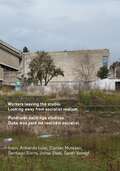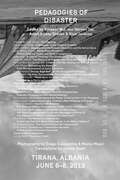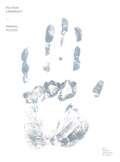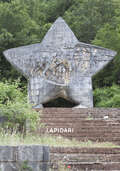- Table View
- List View
Workers Leaving the Studio: Looking Away from Socialist Realism
by Artan ShabaniWorkers Leaving the Studio. Looking Away from Socialist Realism. catalogs the exhibition “Workers leaving the studio. Looking away from socialist realism.,” curated by Mihnea Mircan in the National Gallery of Arts in Tirana, Albania in 2015. According to Mircan, “The […] exhibition reflects on another projection machine, whose history and consequences, unlike cinema, are circumscribed by national boundaries, specific histories, and ideological configurations. The regime of production and representation of socialist realism radicalizes the violence that the creation of a new image does to its subject: it intensifies the fraught relation between refashioned representation and that which is represented. Its insistence on a particular, projective notion of reality is commensurate with the coercion of daily — cultural, social, emotional — life into a grid whose perspective lines and vanishing points carry heavy ideological charges. It enforces what it represents onto that which it represents, so that representation would replace reality.” Apart from a full documentation of the exhibition by photographer Marco Mazzi, the catalogue also features theoretical and art-historical contributions, both in English and in Albanian, on socialist realist art as developed in Albania under the communist regime, as well as texts highlighting contemporary attempts to display political realities through progressive artistic practices. Artists include: Santiago Sierra, Jonas Staal, Ciprian Mureşan, Irwin, Sarah Vanagt, and Armando Lulaj, with scholarly contributions by
Pedagogies of Disaster
by Department Eagles Vincent W. J. Gerven Oei Adam Groves Nico JenkinsWe live in an era where the university system is undergoing great changes owing to developments in financing policies and research priorities, as well as changes in the society in which this system is embedded. This change toward a more market-oriented university, which also has immediate effects in academic peripheries such as the Balkans, the Middle East, or South-East Asia, is of great influence for the pedagogical practice of “less profitable” academic areas such as the Humanities: philosophy, languages, sociology, anthropology, history. Because of the absence of a historically grounded establishment of the Humanities, academic peripheries, usually accompanied by a weak civil society infrastructure, seem to offer the most fertile ground for rethinking the Humanities, their pedagogical practice, and their politics, as well as the greatest threats, such as the ongoing capitalization of research, and profitability as the norm of educational achievement. The sprawling presence of for-profit universities and in academic peripheries such as Albania and Kosovo is indicative of this problematic, as are consistent underfunding of universities and the relentless budget cuts in American and English, and to a lesser extent European, universities. Motivations for this ongoing attack on the university are often driven by a political system or a politics with an aggressive stance to critical thought.
Mineral Policies
by Marko StamenkoviçMineral Policies provides a record of an art residency organized by ZETA Center for Contemporary Art in the mining region of Bulqiza in northeastern Albania, where four artists and activists from Albania, Blerta Hoçia, Diana Malaj, Pleurad Xhafa, and Ergin Zaloshnja, created a collective body of works in close proximity with the local miners, while still maintaining their own discrete sphere of action. This residency followed by a public exhibition, Each Strike Leads to the Next, featuring video works produced during the residency as well as a series of object, curated by Vincent W.J. van Gerven Oei, director of the Department of Eagles in Tirana. This publication includes documentation of the residency and the exhibition, as well the record of a public discussion between curator Van Gerven Oei, former Minister of Finance Arben Malaj, mining engineer Genc Myftiu, and mining worker Bardhul Alla, moderated by cultural journalist Elsa Demo and an interview of cultural theorist Jonida Gashi and Van Gerven Oei with the artists. Mineral Policies documents an important attempt of present-day Albanian artists to reflect on and align themselves with workers and labor activities within a political climate in which neoliberal extractivism and mafia-controlled local and national government have seriously compromised modes of solidarity and survival.
Lapidari 1: Texts
by Vincent Van Gerven OeiIn June and July 2014, philologist Vincent W.J. van Gerven Oei and photographer Marco Mazzi undertook the Albanian Lapidar Survey, a project to map, document, and photograph the large majority of Albanian lapidars, a particular type of monument, mainly produced in the period that the communist Labor Party of Albania ruled the country (1945–1990) to commemorate the partisan victims, battles, and military units from the National Anti-Fascist Liberation War (which coincided with World War II), as well as historical figures from before the liberation and the accomplishments of socialism in Albania afterward. These lapidars, which can still be found, albeit in ever decreasing numbers, all over the country — in cities and villages, alongside roads, in forests and on mountain passes — are witness to an enormous expenditure of labor and resources to turn the landscape into a site of what was called “monumental propaganda.” The Albanian Lapidar Survey aimed to capture these monuments as fact. The results of this project are collected into a three-volume, dual-language (English and Albanian) catalogue, under the title Lapidari. The first volume comprises a series of critical reflections on Albanian monumentality of the period 1945–1990 from a variety of perspectives, as well as historical documents and a full indexation of all inscriptions found on the documented monuments. Volume 2 and Volume 3 feature the photographic documentation of all 649 recorded monumental sites by photographer Marco Mazzi.



